Weider Pro 3000 User Manual
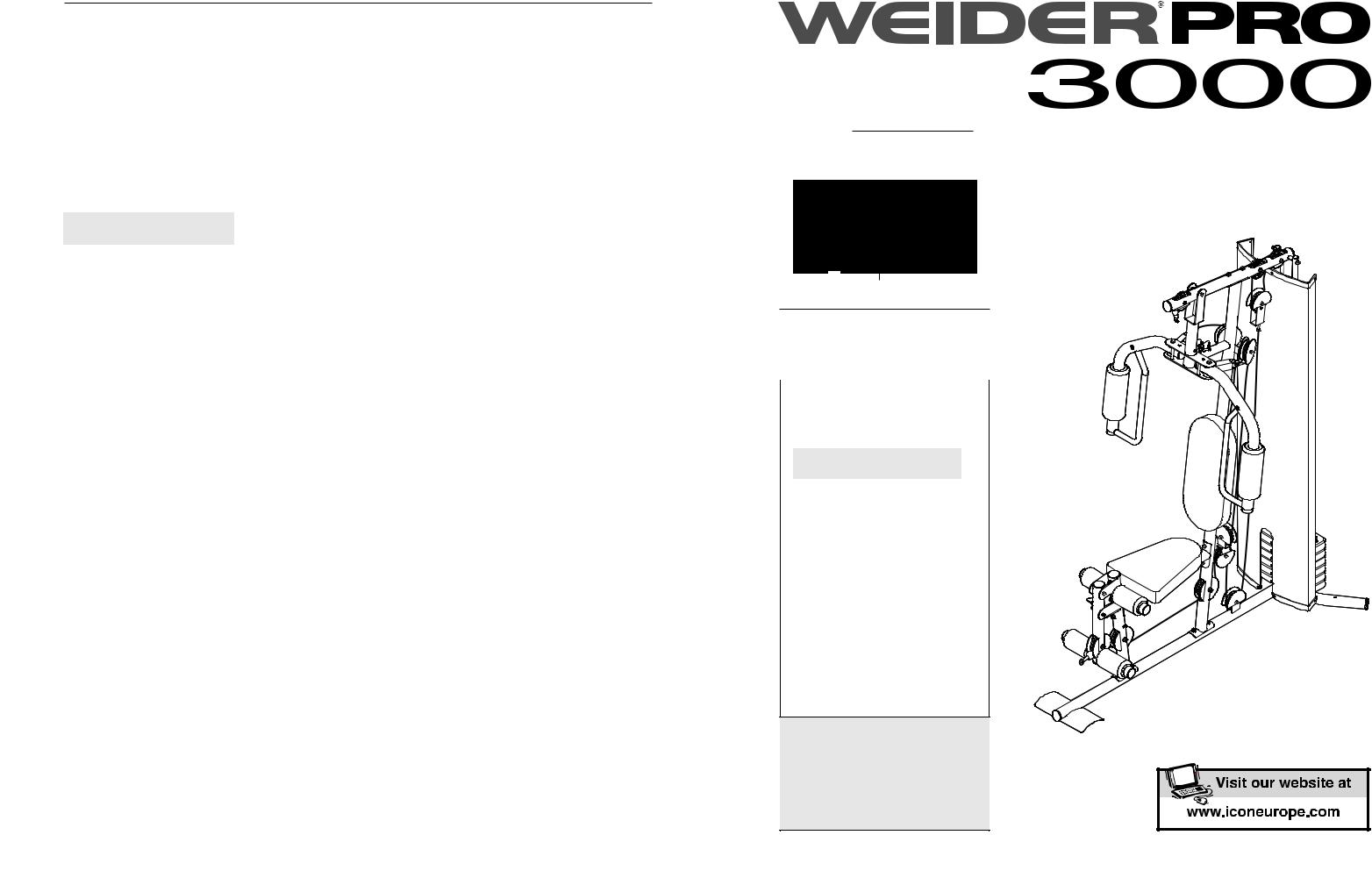
ORDERING REPLACEMENT PARTS
To order replacement parts, contact the ICON Health & Fitness Ltd. office, or write:
ICON Health & Fitness, Ltd.
Customer Service Department
Unit 4, Revie Road Industrial Estate
Revie Road
Beeston
Leeds, LS118JG
UK
Tel:
08457 089 009
Outside the UK: 0 (444) 113 387 7133
Fax: 0 (444) 113 387 7125
To help us assist you, please be prepared to give the following information:
•the MODEL NUMBER of the product (WEEVSY1975.0)
•the NAME of the product (WEIDER PRO 3000 weight system)
•the SERIAL NUMBER of the product (see the front cover of this manual)
•the KEY NUMBER and DESCRIPTION of the part(s) (see the PART LIST and EXPLODED DRAWING in the centre of this manual)
Part No. 232527 R0805A |
Printed in China © 2005 ICON IP, Inc. |
Model No. WEEVSY1975.0
Serial No.
Write the serial number in the space above for future reference.
Serial Number Decal (Under Seat)
Number Decal (Under Seat)
QUESTIONS?
As a manufacturer, we are committed to providing complete customer satisfaction. If you have questions, or if there are missing or damaged parts, please call:
08457 089 009
Or write:
ICON Health & Fitness, Ltd. Unit 4
Revie Road Industrial Estate Revie Road, Beeston Leeds, LS11 8JG
UK
email: csuk@iconeurope.com
 CAUTION
CAUTION
Read all precautions and instructions in this manual before using this equipment. Save this manual for future reference.
USER’S MANUAL
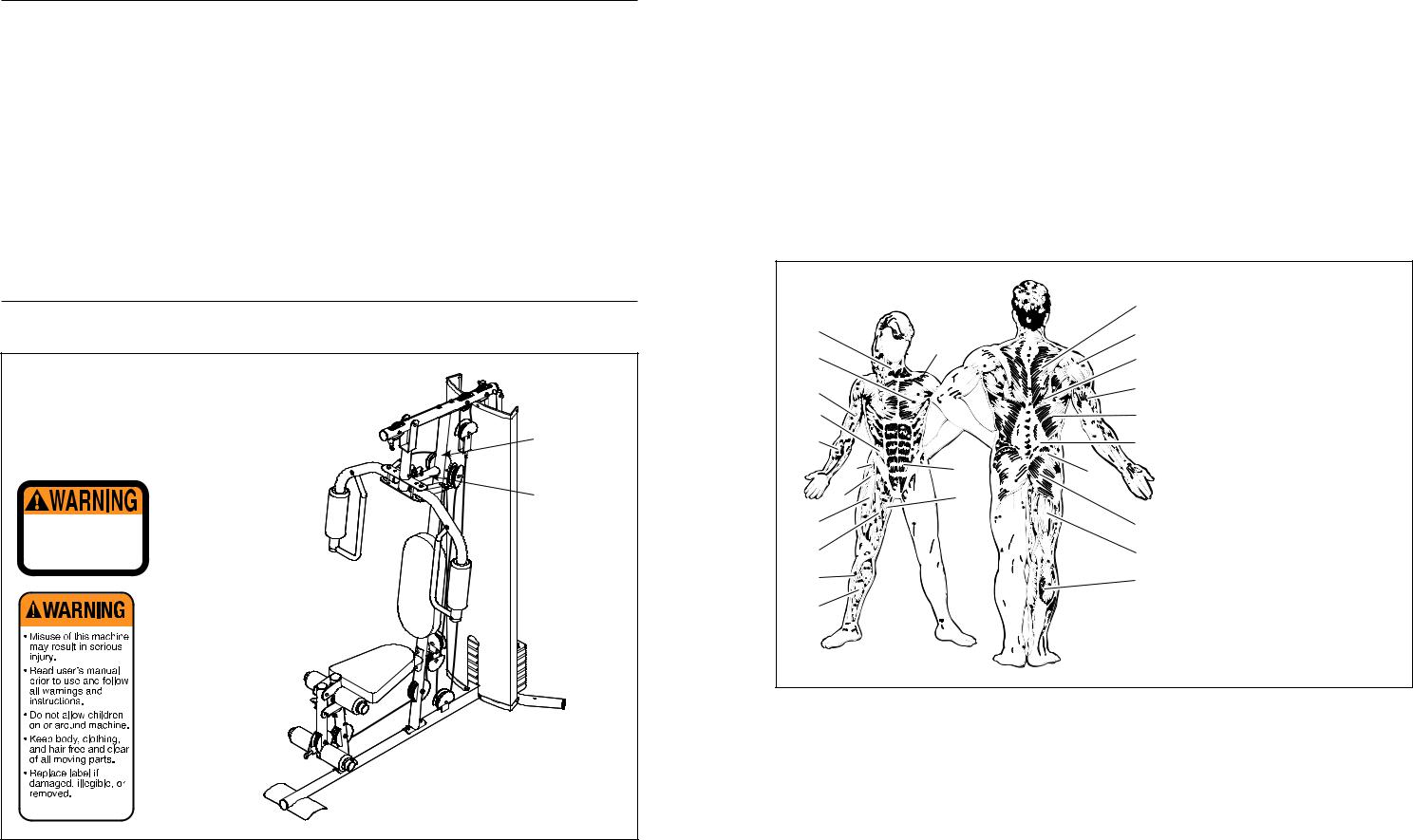
TABLE OF CONTENTS
WARNING DECAL PLACEMENT . . . . . . . . . . . . . . . . . . . . . . . . . . . . . . . . . . . . . . . . . . . . . . . . . . . . . . . . . . . . . 2 IMPORTANT PRECAUTIONS . . . . . . . . . . . . . . . . . . . . . . . . . . . . . . . . . . . . . . . . . . . . . . . . . . . . . . . . . . . . . . . . 3 BEFORE YOU BEGIN . . . . . . . . . . . . . . . . . . . . . . . . . . . . . . . . . . . . . . . . . . . . . . . . . . . . . . . . . . . . . . . . . . . . . . 4 ASSEMBLY . . . . . . . . . . . . . . . . . . . . . . . . . . . . . . . . . . . . . . . . . . . . . . . . . . . . . . . . . . . . . . . . . . . . . . . . . . . . . . 5 ADJUSTMENTS . . . . . . . . . . . . . . . . . . . . . . . . . . . . . . . . . . . . . . . . . . . . . . . . . . . . . . . . . . . . . . . . . . . . . . . . . . 17 WEIGHT RESISTANCE CHART . . . . . . . . . . . . . . . . . . . . . . . . . . . . . . . . . . . . . . . . . . . . . . . . . . . . . . . . . . . . . .19 CABLE DIAGRAMS . . . . . . . . . . . . . . . . . . . . . . . . . . . . . . . . . . . . . . . . . . . . . . . . . . . . . . . . . . . . . . . . . . . . . . .20 MAINTENANCE . . . . . . . . . . . . . . . . . . . . . . . . . . . . . . . . . . . . . . . . . . . . . . . . . . . . . . . . . . . . . . . . . . . . . . . . . .21 EXERCISE GUIDELINES . . . . . . . . . . . . . . . . . . . . . . . . . . . . . . . . . . . . . . . . . . . . . . . . . . . . . . . . . . . . . . . . . . 22 ORDERING REPLACEMENT PARTS . . . . . . . . . . . . . . . . . . . . . . . . . . . . . . . . . . . . . . . . . . . . . . . . . .Back Cover
Note: A PART IDENTIFICATION CHART and a PART LIST/EXPLODED DRAWING are attached in the centre of this manual. Remove the PART IDENTIFICATION CHART and PART LIST/EXPLODED DRAWING before beginning assembly.
WARNING DECAL PLACEMENT
The decals shown here have been placed on the weight system. If a decal is missing, or if it is not legible, please call our Customer Service Department and order a free replacement decal (see the back cover of this manual). Apply the replacement decal in the location shown.
Keep hands and |
|
fingers clear of |
|
this area. |
Decal 1 |
|
Decal 2 |
Decal 1—This |
decal is placed |
on both sides |
of the upright |
Decal 2
WEIDER is a registered trademark of ICON IP, Inc.
Rest for a short period of time after each set. The ideal resting periods are:
•Rest for three minutes after each set for a muscle building workout.
•Rest for one minute after each set for a toning workout.
•Rest for 30 seconds after each set for a weight loss
workout.
Plan to spend the first couple of weeks familiarising yourself with the equipment and learning the proper form for each exercise.
COOLING DOWN
End each workout with 5 to 10 minutes of stretching. Include stretches for both your arms and legs. Move
slowly as you stretch and do not bounce. Ease into each stretch gradually and go only as far as you can without strain. Stretching at the end of each workout is an effective way to increase flexibility.
STAYING MOTIVATED
For motivation, keep a record of each workout. List the date, the exercises performed, the resistance used, and the numbers of sets and repetitions completed. Record your weight and key body measurements at the end of every month. Remember, the key to achieving the greatest results is to make exercise a regular and enjoyable part of your everyday life.
|
|
|
MUSCLE CHART |
||
|
|
O |
A. |
Sternomastoid (neck) |
|
A |
|
|
|||
|
P |
B. |
Pectoralis Major (chest) |
||
|
L |
C. |
Biceps (front of arm) |
||
B |
Q |
||||
D. |
Obliques (waist) |
||||
|
|||||
|
|
R |
E. |
Brachioradials (forearm) |
|
C |
|
F. |
Hip Flexors (upper thigh) |
||
D |
|
S |
G. |
Abductor (outer thigh) |
|
|
H. |
Quadriceps (front of thigh) |
|||
|
|
||||
|
|
|
|||
E |
|
T |
I. |
Sartorius (front of thigh) |
|
|
J. |
Tibialis Anterior (front of calf) |
|||
|
|
||||
|
|
|
|||
F |
M |
U |
K. |
Soleus (front of calf) |
|
|
|
L. |
Anterior Deltoid (shoulder) |
||
|
|
|
|||
G |
N |
|
M. |
Rectus Abdominus (stomach) |
|
H |
|
|
N. |
Adductor (inner thigh) |
|
|
V |
O. |
Trapezius (upper back) |
||
I |
|
W |
P. |
Rhomboideus (upper back) |
|
|
Q. |
Posterior Deltoid (shoulder) |
|||
|
|
||||
J |
|
X |
R. |
Triceps (back of arm) |
|
|
S. |
Latissimus Dorsi (mid back) |
|||
|
|
|
|||
K |
|
|
T. |
Spinae Erectors (lower back) |
|
|
|
U. |
Gluteus Medius (hip) |
||
|
|
|
|||
|
|
|
V. |
Gluteus Maximus (buttocks) |
|
|
|
|
W. |
Hamstring (back of leg) |
|
|
|
|
X. |
Gastrocnemius (back of calf) |
|
2 |
23 |
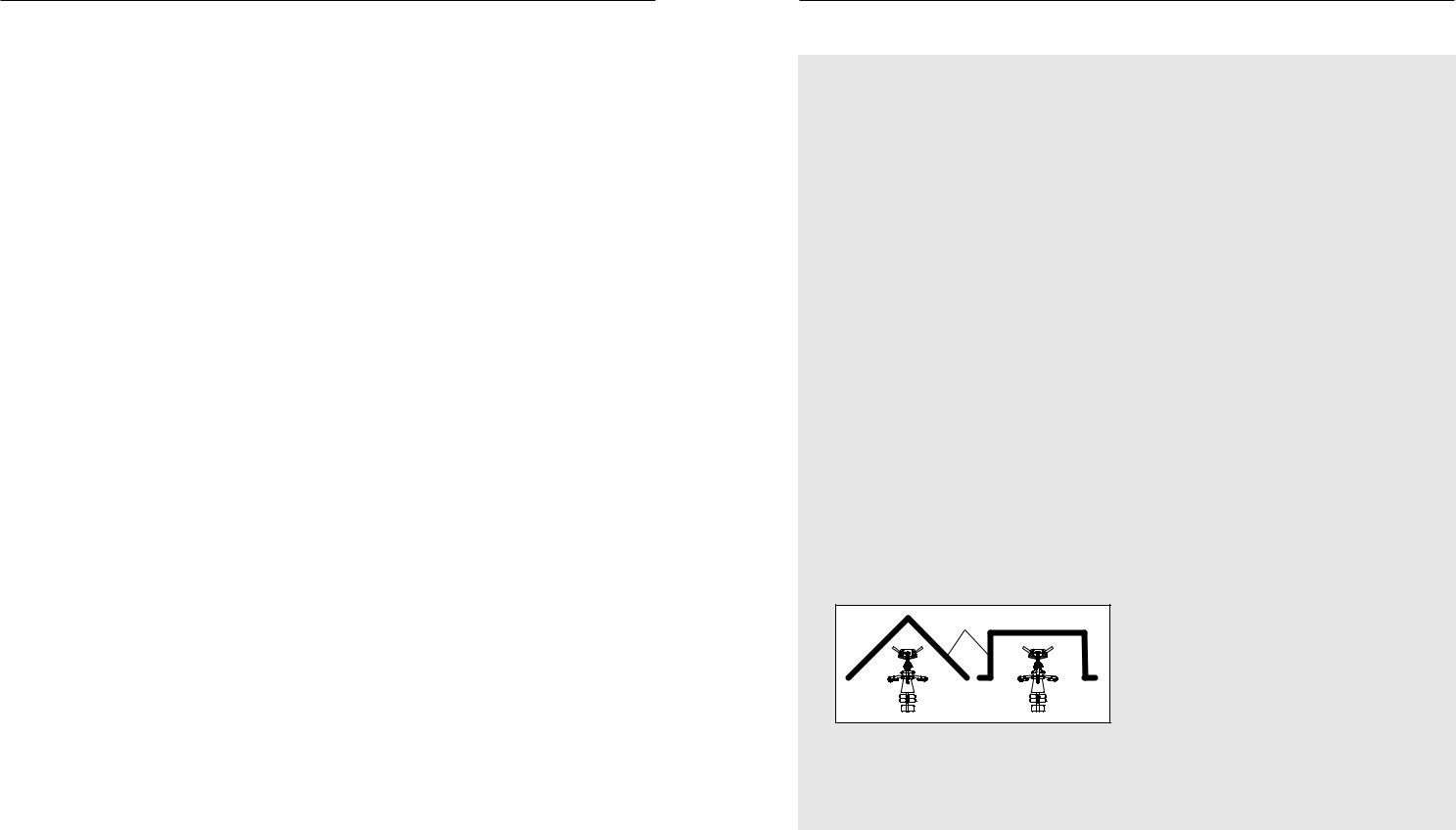
EXERCISE GUIDELINES
THE FOUR BASIC TYPES OF WORKOUTS
Muscle Building
To increase the size and strength of your muscles, push them close to their maximum capacity. Your muscles will continually adapt and grow as you progressively increase the intensity of your exercise. You can adjust the intensity level of an individual exercise in two ways:
•by changing the amount of resistance used
•by changing the number of repetitions or sets performed. (A “repetition” is one complete cycle of an exercise, such as one sit-up. A “set” is a series of repetitions.)
The proper amount of resistance for each exercise depends upon the individual user. You must gauge your limits and select the amount of resistance that is right for you. Begin with 3 sets of 8 repetitions for each exercise you perform. Rest for 3 minutes after each set. When you can complete 3 sets of 12 repetitions without difficulty, increase the amount of resistance.
Toning
You can tone your muscles by pushing them to a moderate percentage of their capacity. Select a moderate amount of resistance and increase the number of repetitions in each set. Complete as many sets of 15 to 20 repetitions as possible without discomfort. Rest for 1 minute after each set. Work your muscles by completing more sets rather than by using high amounts of resistance.
Weight Loss
To lose weight, use a low amount of resistance and increase the number of repetitions in each set. Exercise for 20 to 30 minutes, resting for a maximum of 30 seconds between sets.
Cross Training
Cross training is an efficient way to get a complete and well-balanced fitness program. An example of a balanced program is:
•Plan strength training workouts on Monday, Wednesday, and Friday.
•Plan 20 to 30 minutes of aerobic exercise, such as running on a treadmill or riding on an exercise cycle or an elliptical exerciser, on Tuesday and Thursday.
•Rest from both strength training and aerobic exercise for at least one full day each week to give your body time to regenerate.
The combination of strength training and aerobic exercise will reshape and strengthen your body, plus develop your heart and lungs.
PERSONALISING YOUR EXERCISE PROGRAM
Determining the exact length of time for each workout, as well as the number of repetitions or sets completed, is an individual matter. It is important to avoid overdoing it during the first few months of your exercise program. You should progress at your own pace and be sensitive to your body’s signals. If you experience pain or dizziness at any time while exercising, stop immediately and begin cooling down. Find out what is wrong before continuing. Remember that adequate rest and a proper diet are important factors in any exercise program.
WARMING UP
Begin each workout with 5 to 10 minutes of stretching and light exercise to warm up. Warming up prepares your body for more strenuous exercise by increasing circulation, raising your body temperature and delivering more oxygen to your muscles.
WORKING OUT
Each workout should include 6 to 10 different exercises. Select exercises for every major muscle group, emphasising areas that you want to develop most. To give balance and variety to your workouts, vary the exercises from session to session.
Schedule your workouts for the time of day when your energy level is the highest. Each workout should be followed by at least one day of rest. Once you find the schedule that is right for you, stick with it.
EXERCISE FORM
Maintaining proper form is an essential part of an effective exercise program. This requires moving through the full range of motion for each exercise, and moving only the appropriate parts of the body. Exercising in an uncontrolled manner will leave you feeling exhausted. On the exercise guide accompanying this manual you will find photographs showing the correct form for several exercises, and a list of the muscles affected. Refer to the muscle chart on the next page to find the names of the muscles.
The repetitions in each set should be performed smoothly and without pausing. The exertion stage of each repetition should last about half as long as the return stage. Proper breathing is important. Exhale during the exertion stage of each repetition and inhale during the return stroke. Never hold your breath.
IMPORTANT PRECAUTIONS
 WARNING: To reduce the risk of serious injury, read the following important precautions before using the weight system.
WARNING: To reduce the risk of serious injury, read the following important precautions before using the weight system.
1.Read all instructions in this manual and all warnings on the weight system before using the weight system. Use the weight system only as described in this manual.
2.It is the responsibility of the owner to ensure that all users of the weight system are adequately informed of all precautions.
3.The weight system is intended for home use only. Do not use the weight system in any commercial, rental, or institutional setting.
4.Keep the weight system indoors, away from moisture and dust. Place the weight system on a level surface, with a mat beneath it to protect the floor or carpet. Make sure that there is enough clearance around the weight system to mount, dismount, and use the weight system.
5.This weight system has an open weight stack; the weight stack must not be accessable from any point outside of the user’s field of view. To prevent access to the weight stack, place the weight system in a corner or bay of a room, as shown in the drawing below. There must be no more than 1 meter (3 ft. 4 in.) of clearance between the weight system and the adjacent walls.
Wall |
6.Keep children under 12 and pets away from the weight system at all times.
7.Make sure all parts are properly tightened each time the weight system is used. Replace any worn parts immediately.
8.Always wear athletic shoes for foot protection while exercising.
9.Keep hands and feet away from moving parts.
10.The weight system is designed to support a maximum user weight of 135 kg (300 lbs.).
11.Always secure the weight stack with the lock pin and lock after exercising to prevent unauthorised use of the weight system (see LOCKING THE WEIGHT STACK on page 18).
12.Make sure that the cables remain on the pulleys at all times. If the cables bind as you are exercising, stop immediately and make sure that the cables are on the pulleys.
13.Always stand on the foot plate when performing an exercise that could cause the weight system to tip.
14.Never release the arms, leg lever, lat bar, or handle strap while weights are raised. The weights will fall with great force.
15.Always disconnect the lat bar from the weight system when performing an exercise that does not use the lat bar.
16.If you feel pain or dizziness while exercising, stop immediately and begin cooling down.
 WARNING: Before beginning this or any exercise program, consult your physician. This is especially important for persons over the age of 35 or persons with pre-existing health problems. Read all instructions before using. ICON assumes no responsibility for personal injury or property damage sustained by or through the use of this product.
WARNING: Before beginning this or any exercise program, consult your physician. This is especially important for persons over the age of 35 or persons with pre-existing health problems. Read all instructions before using. ICON assumes no responsibility for personal injury or property damage sustained by or through the use of this product.
22 |
3 |
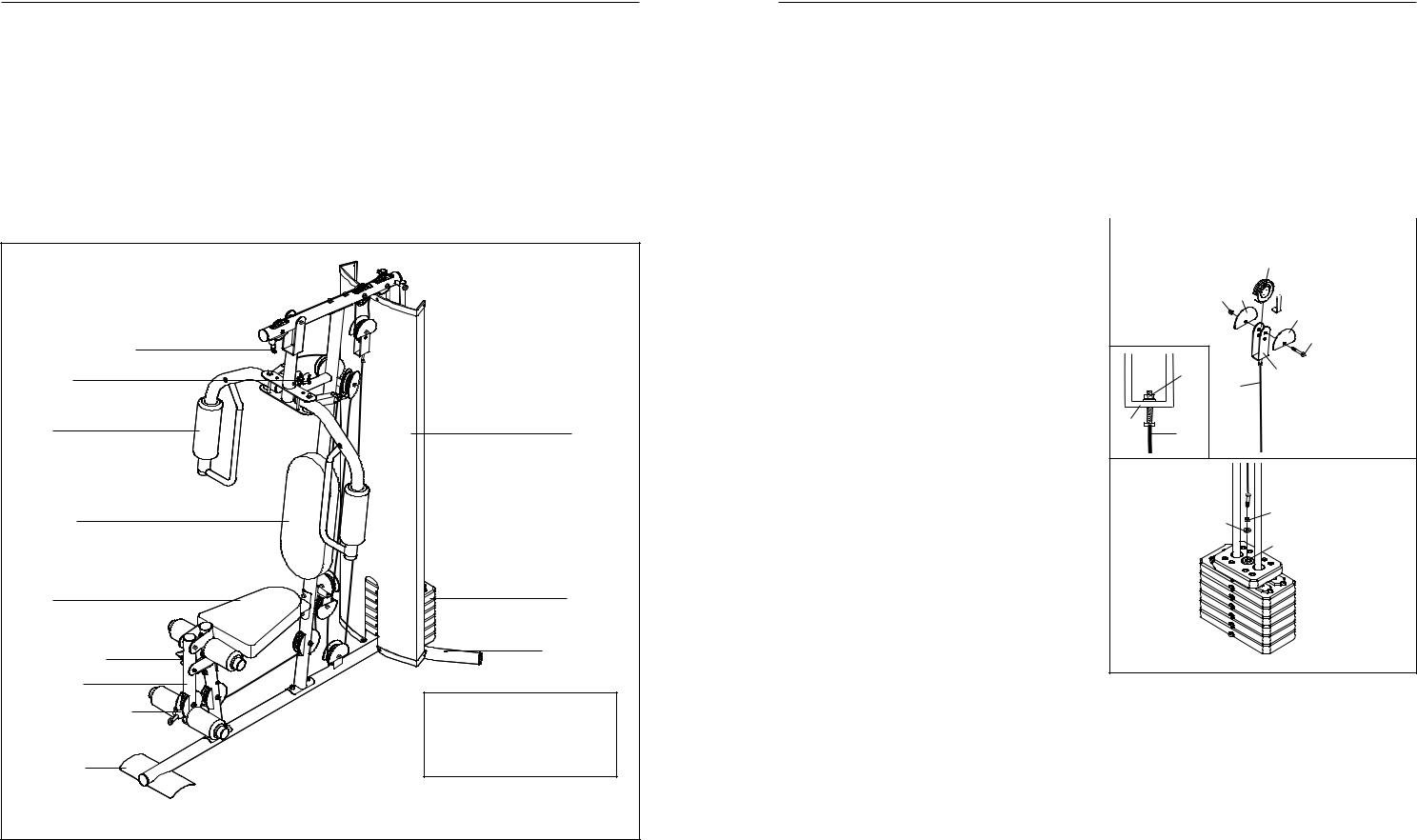
BEFORE YOU BEGIN
Thank you for selecting the versatile WEIDER® PRO 3000 weight system. The weight system offers a selection of weight stations designed to develop every major muscle group of the body. Whether your goal is to tone your body, build dramatic muscle size and strength, or improve your cardiovascular system, the weight system will help you to achieve the specific results you want.
For your benefit, read this manual carefully before using the weight system. If you have questions after
reading this manual, please call our Customer Service Department at 08457 089 009. To help us assist you, please note the product model number and serial number before calling. The model number is WEEVSY1975.0. The serial number can be found on a decal attached to the weight system (see the front cover of this manual).
Before reading further, please review the drawing below and familiarise yourself with the parts that are labelled.
|
Note: The terms “right side” |
|
|
and “left side” are deter- |
|
|
mined relative to a person |
|
|
sitting on the seat; they do |
|
|
not correspond to right and |
|
High Pulley Station |
left on the drawings in this |
|
manual. |
||
|
||
Arm Pin |
|
|
Arm |
Shroud |
Backrest |
|
|
|
|
|
|
Right Side |
|
|
|
|
Seat |
|
|
|
|
Weights |
Leg Lever Pin |
|
|
|
|
*Anchor Hole |
|
|
|
|
|
|
Leg Lever |
|
|
|
|
|
Low Pulley Station |
Left Side |
ASSEMBLED DIMENSIONS: |
|||
|
Height: |
76 in. |
/ |
193 cm |
|
|
|
||||
|
|
Width: |
37 in. |
/ |
94 cm |
Foot Plate |
|
Depth: |
48 in. |
/ |
122 cm |
|
|
|
|
|
|
|
*Note: Use the anchor holes to secure the |
||||
|
weight system to a fixed position, if desired. |
||||
MAINTENANCE
Make sure all parts are properly tightened each time the weight system is used. Replace any worn parts immediately. The weight system can be cleaned with a damp cloth and a mild, non-abrasive detergent. Do not use solvents.
TIGHTENING THE CABLES
Woven cable, the type of cable used on the weight system, can stretch slightly when it is first used. If there is slack in the cables before resistance is felt, the cables should be tightened. To tighten the cables, first insert the weight pin into the middle of the weight stack. Slack can be removed from these cables several ways:
•See drawing 1 inset. Tighten the M8 Nylon Locknut (58) that connects the end of the Low Cable (53) to the “U”-bracket (45).
•See drawing 1. Remove the M10 Nylon Locknut (56) and the M10 x 51mm Bolt (66) from the Cable Trap (51), 90mm Pulley (48), the two Half Finger Guards (43), and “U”-bracket (45). Reattach the Pulley, Cable Trap, and Finger Guards to the other hole in the “U”-bracket. Make sure that the Cable Trap is in the proper position and that the Cable and Pulley move smoothly.
•See drawing 2. Loosen the M12 Nut (84) on the High Cable (55). Tighten the High Cable into the Weight Tube (24) until the slack is removed from the Cable. Retighten the M12 Nut against the Large Washer (85).
1
48
51
56 43 



43
66
|
58 |
45 |
|
|
53 |
45 |
53 |
|
|
|
2
55 
84
85
24
Do not overtighten the cables. If the cables are overtightened, the top weight will be lifted off the weight stack. If a cable tends to slip off the pulleys often, it may have become twisted. Remove the cable and re-install it. If the cables need to be replaced, see ORDERING REPLACEMENT PARTS on the back cover of this manual.
4 |
21 |
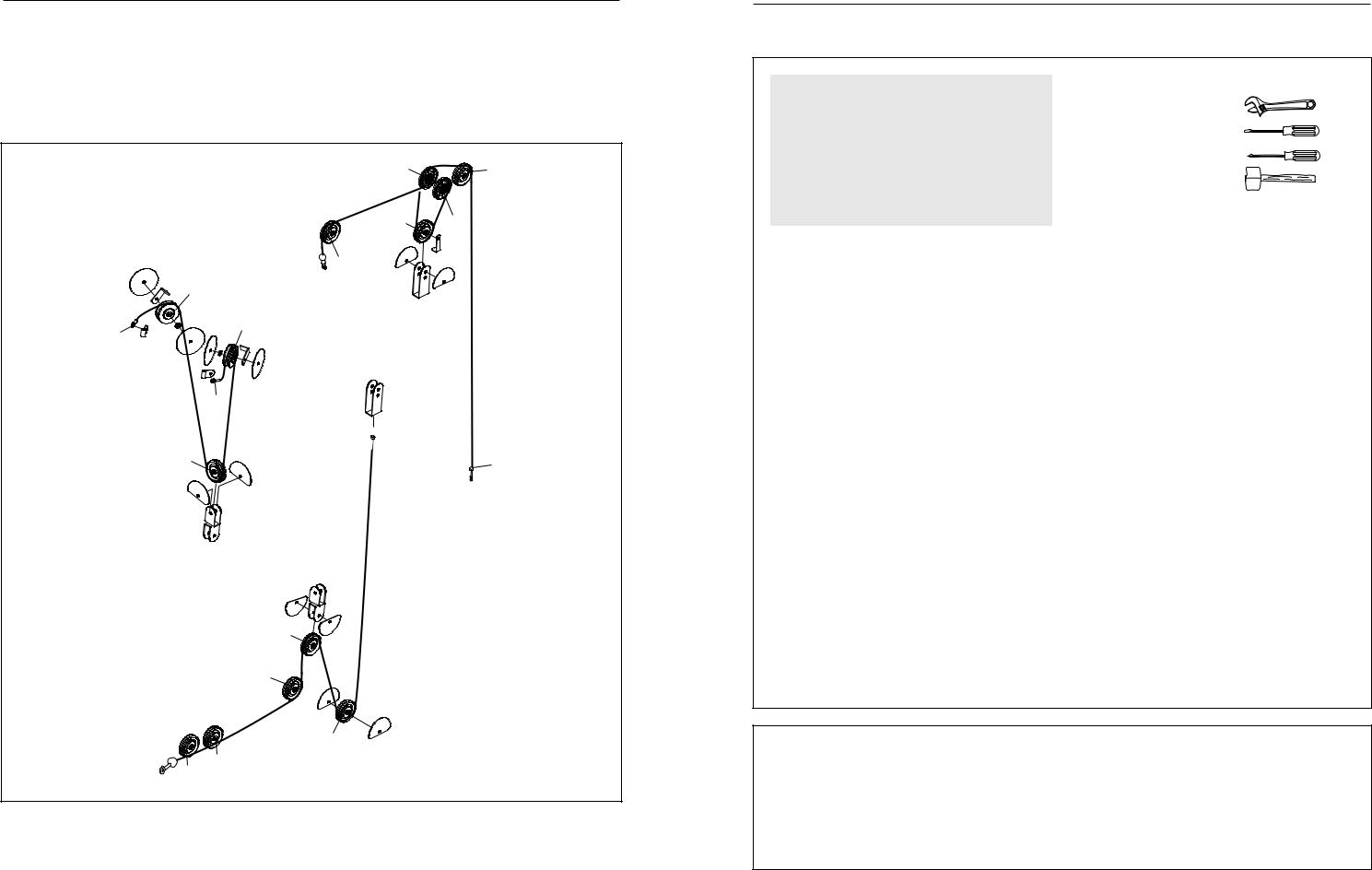
CABLE DIAGRAMS
The cable diagrams below show the proper routing of the Low Cable (53), the Arm Cable (54), and the High Cable (55). Use the diagrams to make sure that the cables, cable traps, and finger guards have been assembled correctly. If the cables have not been correctly routed, the weight system will not function properly and damage may occur. The numbers show the correct route for each cable. Make sure that the cable traps do not touch or bind the cables.
5
Arm Cable (54)
Length: 89 inches
4 |
5 |
High Cable (55) |
|
Length: 114 inches |
|
3 |
2 |
1 |
|
4
2
1
 6
6
3 |
6 |
|
4
Low Cable (53)
Length: 128 inches
3
5
2
1
ASSEMBLY
Make Assembly Easier for Yourself
Everything in this manual is designed to ensure that the weight system can be assembled successfully by anyone. Before beginning assembly, make sure to read the information on this page. This brief introduction will save you much more time than it takes to read it.
Assembly Requires Two Persons
For your convenience and safety, assemble the weight system with the help of another person.
Set Aside Enough Time
Due to the many features of the weight system, the assembly process will require several hours. By setting aside plenty of time and by deciding to make the task enjoyable, assembly will go smoothly. You may want to assemble the weight system over a couple of evenings.
Select a Location for the Weight System
Because of its weight and size, the weight system should be assembled in the location where it will be used. Make sure that there is enough room to walk around the weight system as you assemble it.
How to Unpack the Box
To make assembly as easy as possible, we have divided the assembly process into four stages. The parts needed for each stage are found in individual bags. Important: Wait until you begin each stage to open the parts bag for that stage. Place all parts of the weight system in a cleared area and remove the packing materials. Do not dispose of the packing materials until assembly is completed.
Make sure you have the following tools:
• Two adjustable spanners
• One standard screwdriver
• One phillips screwdriver
• One rubber mallet
•One Allen wrench (included) 
•You will also need grease or petroleum jelly, a small amount of soapy water, and clear tape or masking tape.
Note: Assembly will be more convenient if you have a socket set, a set of open-end or closed-end spanners, or a set of ratchet spanners.
How to Identify Parts
To help you identify the small parts used in assembly, we have included a PART IDENTIFICATION CHART in the centre of this manual. Place the chart on the floor and use it to easily identify parts during each assembly step. Note: Some small parts may have been pre-attached. If a part is not in the parts bag, check to see if it has been pre-attached.
How to Orient Parts
As you assemble the weight system, all parts must be oriented exactly as shown in the drawings.
Tightening Parts
Tighten all parts as you assemble them, unless instructed to do otherwise.
Questions?
If you have questions after reading the assembly instructions, please call our Customer Service Department at 0845 7089009
The Four Stages of the Assembly Process
Frame Assembly—You will begin by assembling |
Cable Assembly—During this stage you will |
the base and the uprights that form the skeleton of |
attach the cables and pulleys that connect the |
the weight system. |
arms to the weights. |
Arm Assembly—During this stage you will |
Seat Assembly—During the final stage you will |
assemble the arms and the leg lever. |
assemble the seats and the backrests. |
|
|
20 |
5 |
